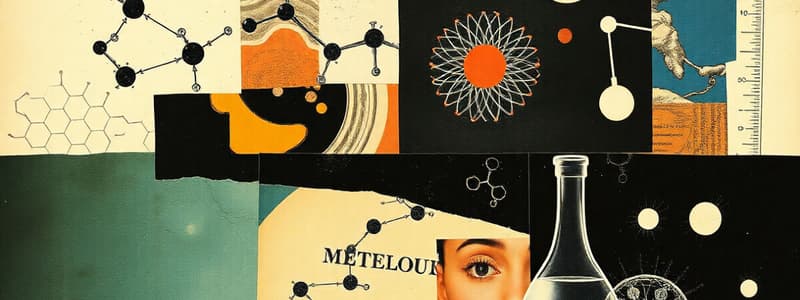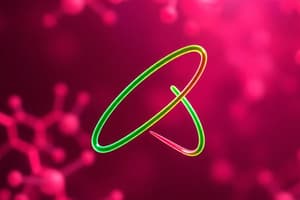Podcast
Questions and Answers
Un atome est électriquement neutre, cela signifie que le nombre de protons est égal au nombre de neutrons.
Un atome est électriquement neutre, cela signifie que le nombre de protons est égal au nombre de neutrons.
False (B)
Qu'est-ce qui provoque la formation d'une liaison covalente?
Qu'est-ce qui provoque la formation d'une liaison covalente?
La mise en commun d'électrons entre deux atomes.
Quels sont les quatre éléments chimiques qui composent majoritairement les molécules du vivant?
Quels sont les quatre éléments chimiques qui composent majoritairement les molécules du vivant?
- Chlore, Calcium, Soufre, Magnésium
- Hydrogène, Carbone, Azote, Oxygène (correct)
- Carbone, Sodium, Phosphore, Potassium
- Oxygène, Hydroxide, Soufre, Azote
Quels sont les deux types de constituants minéraux ?
Quels sont les deux types de constituants minéraux ?
Quels sont les cinq rôles de l'eau ?
Quels sont les cinq rôles de l'eau ?
Quel est le rôle principal du dioxyde de carbone dans le métabolisme ?
Quel est le rôle principal du dioxyde de carbone dans le métabolisme ?
Qu'est-ce qu'un acide gras insaturé?
Qu'est-ce qu'un acide gras insaturé?
Quelle est la molécule qui transporte l'oxygène dans le sang ?
Quelle est la molécule qui transporte l'oxygène dans le sang ?
Qu'est-ce qu'un acide aminé?
Qu'est-ce qu'un acide aminé?
Tous les acides aminés sont essentiels à la vie.
Tous les acides aminés sont essentiels à la vie.
Quel est le rôle des enzymes dans le métabolisme ?
Quel est le rôle des enzymes dans le métabolisme ?
Quel est le principal lieu de production d'ATP dans la cellule?
Quel est le principal lieu de production d'ATP dans la cellule?
Qu'est-ce qui représente environ 65% du corps humain ?
Qu'est-ce qui représente environ 65% du corps humain ?
Les glucides sont des molécules organiques qui sont constituées de carbone, d'hydrogène et d'azote.
Les glucides sont des molécules organiques qui sont constituées de carbone, d'hydrogène et d'azote.
Quelle est la fonction principale des lipides?
Quelle est la fonction principale des lipides?
Flashcards
La molécule d'eau
La molécule d'eau
Une substance composée de deux atomes d'hydrogène et d'un atome d'oxygène, liés par des liaisons covalentes polaires.
Polarité
Polarité
La capacité d'une molécule à attirer ou à repousser les électrons, créant des pôles chargés positivement et négativement.
Milieu intracellulaire
Milieu intracellulaire
Le milieu à l'intérieur des cellules, rempli de liquide et d'organites.
Milieu extracellulaire
Milieu extracellulaire
Signup and view all the flashcards
Solution aqueuse ionique
Solution aqueuse ionique
Signup and view all the flashcards
Osmolarité
Osmolarité
Signup and view all the flashcards
Solution isotonique
Solution isotonique
Signup and view all the flashcards
Hydrophilicité
Hydrophilicité
Signup and view all the flashcards
Hydrophobie
Hydrophobie
Signup and view all the flashcards
Transpiration
Transpiration
Signup and view all the flashcards
Propriété acido-basique
Propriété acido-basique
Signup and view all the flashcards
Dioxygène (O2)
Dioxygène (O2)
Signup and view all the flashcards
Transport de l'O2
Transport de l'O2
Signup and view all the flashcards
Dioxyde de carbone (CO2)
Dioxyde de carbone (CO2)
Signup and view all the flashcards
Monoxyde de carbone (CO)
Monoxyde de carbone (CO)
Signup and view all the flashcards
Glucides
Glucides
Signup and view all the flashcards
Monosaccharides
Monosaccharides
Signup and view all the flashcards
Disaccharides
Disaccharides
Signup and view all the flashcards
Polysaccharides
Polysaccharides
Signup and view all the flashcards
Lipides
Lipides
Signup and view all the flashcards
Acides gras
Acides gras
Signup and view all the flashcards
Glycérides
Glycérides
Signup and view all the flashcards
Phospholipides
Phospholipides
Signup and view all the flashcards
Cholestérol
Cholestérol
Signup and view all the flashcards
Protides
Protides
Signup and view all the flashcards
Acides aminés
Acides aminés
Signup and view all the flashcards
Métabolisme
Métabolisme
Signup and view all the flashcards
Anabolisme
Anabolisme
Signup and view all the flashcards
Catabolisme
Catabolisme
Signup and view all the flashcards
Métabolisme aérobie
Métabolisme aérobie
Signup and view all the flashcards
Métabolisme anaérobie
Métabolisme anaérobie
Signup and view all the flashcards
Study Notes
Introduction to Molecules of Life
- Molecules of life, or biological molecules, are primarily composed of carbon, hydrogen, oxygen, and nitrogen.
- These molecules are vital for carrying out various functions in living organisms.
Atoms, Ions, and Chemical Bonds
- Atoms are electrically neutral; the number of protons equals the number of electrons.
- Isotopes: atoms with the same number of protons but a different number of neutrons.
- Ions: atoms that have gained or lost electrons, leading to a positive (cation) or negative (anion) charge.
- Chemical bonds (strong and weak) link atoms to form molecules. Strong bonds include covalent bonds (sharing electrons) and ionic bonds (transfer of electrons). Weak bonds, such as hydrogen bonds, are important for molecular interactions.
Water
- Water is a crucial molecule in living organisms.
- Water is polar, meaning it has a slightly positive and slightly negative end. This polarity allows it to form hydrogen bonds, which are crucial for its unique properties.
- Water is a versatile solvent, dissolving many polar and ionic substances, as well as a role in transport.
- Water plays a crucial role in regulating temperature due to its high specific heat capacity.
- Water also has high cohesion due to the hydrogen bonds between water molecules, which contributes to properties like surface tension.
Inorganic Molecules
- Inorganic compounds do not contain carbon bonded to hydrogen.
- Examples include water (H₂O) and mineral salts.
Major Elements in Living Organisms
- The four major elements (oxygen, carbon, hydrogen, and nitrogen) make up 99% of the body's mass.
- Mineral salts contribute significantly to the body's structures and functions.
- Trace minerals are needed in small amounts for normal function.
Organic Molecules
- Organic molecules are primarily composed of carbon and hydrogen.
- Carbohydrates, lipids, proteins, and nucleic acids are major types of organic molecules.
Carbohydrates
- Carbohydrates are composed of carbon, hydrogen, and oxygen atoms.
- Monosaccharides, disaccharides, and polysaccharides are different forms of carbohydrates.
- Carbohydrates serve as a primary energy source for cells.
Lipids
- Lipids are composed of carbon, hydrogen, and oxygen.
- Lipids are hydrophobic and insoluble in water.
- Lipids provide insulation, protection, and energy storage.
Proteins
- Proteins are polymers of amino acids.
- Proteins have diverse functions, including enzymes, structural components, and hormones.
- Proteins are essential for virtually all cellular functions.
Nucleic Acids
- Nucleic acids (DNA and RNA) store and transmit genetic information.
- Composed of nucleotides, which include a sugar, a phosphate group, and a nitrogenous base.
- DNA stores genetic information.
- RNA translates and transfers genetic information.
Metabolism
- Metabolism encompasses all the chemical reactions in an organism.
- Catabolism: the breakdown of complex molecules to release energy.
- Anabolism: the synthesis of complex molecules requiring energy.
Studying That Suits You
Use AI to generate personalized quizzes and flashcards to suit your learning preferences.
Related Documents
Description
Ce quiz aborde les concepts fondamentaux de la biologie liés aux molécules du vivant. Testez vos connaissances sur les éléments chimiques, les types de liens, et le rôle essentiel de l'eau et des enzymes dans le métabolisme. Préparez-vous à découvrir les bases qui constituent la vie sous toutes ses formes.




